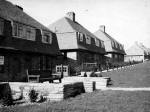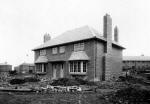 |
The History of Council Housing |
  |
|
|
4 Inter-war Slum Clearance
 |
The high building standards initially embraced in 1919 were gradually reduced
during the 1920s and 1930s, as cost considerations became paramount space and
amenities were reduced. The principle objective of the Wheatley Act of 1924 was
to secure a continuous building programme for period of 15 years and to
erect houses that could be let at lower rents to meet the position of
lower wage earners. This put pressures to reduce the size and standard of houses and
called for new council estates to be developed at a higher density. For
instance, during this period, a new three bedroom house was often only
620 square feet compared to over 1000 square feet in 1919. New council
housing was gradually becoming residualised and labelled for the very
poor, despite this they generally continued to provide good quality
accommodation. |
 |
 |
After this initial burst of building activity across the country targeted at reducing the
post-war housing shortage, local councils began to tackle the problem of its
existing slum housing. The Housing Act of 1930 encouraged mass slum
clearance and councils set to work to demolish poor quality housing and replace
with new build. The photo on the left shows a designated Slum Officer
at work to prioritise the demolition. Slum areas of housing existed in most inner city areas
and were generally old, neglected and unhealthy places to live. Many of the
houses had originally built for workers during the period of rapid industrial
development often without thought for overcrowding or amenities such as an
adequate water supply, ventilation and sunlight. Using powers available under
the Act to acquire and demolish privately owned properties, slum clearance
schemes were put into action across the country. |
 |
 |
By 1933 all authorities were required to concentrate efforts on slum
clearance; each had to submit a programme of building and demolition aimed at
eliminating slums from their districts. The city of Bristol had calculated they
had 25,000 people living in houses unfit for human habitation and proposed the
replacement of 5,000 unfit dwellings. Unlike the garden estates built directly after the First World War, much of
the slum clearance was replaced with flats, mostly three to five storeys high.
They were often modelled on schemes in continental Europe such as the
Quarry Hill flats in Leeds (shown left) which were inspired by a tour
the Karl Marx building - workers flats in Vienna. Non-traditional
building techniques were embraced - the photo to the right shows the
steel framework for two of the units that would comprise Quarry Hill
which was at this time the largest council house project in Europe. |
 |
 |
 |
 |
Local councils tried initially to rehouse people locally back into the communities they
were forced to vacate following the demolition of inner city slum areas. However
central redevelopment was only ever confined to relatively small schemes
at this time and the vast
majority of new houses were built on new estates, most located on the fringes of
the cities. This was a combination of central policy and the high cost of inner
city land. The new tenants had to weigh up the disadvantage of a considerably
longer journey to work and sense of isolation against the benefits of a new well
equipped home.
Rents were generally lower in this period than they were for earlier
schemes built under the 1919 Housing Act. Despite this and a general
commitment to house those in most need, in practice the ability to pay
the rent played a crucial factor in allocation. Rents were set much
lower following the 1930 Housing Act in line with re-housing some of the
poorest people in society under slum clearance policy. |
 |
 |
Tenancy conditions were strict and regulations were enforced from
the start. Some tenants were put off by the oppressive housing
management. In Liverpool women housing managers were employed to inspect
properties and instruct tenants on good housekeeping. Below is an
extract from a letter to new tenant from the Corporation of Bristol
Housing Estates on 15th June 1936 making an offer of a new house on the
Knowle West estate. |
 |
|
 |
“The Housing Committee realise that you have
been living under very undesirable conditions, and that in worn out
houses it is very difficult to get rid of vermin. But there will be no
excuse in your new house. Do not buy secondhand furniture, bedding or
pictures unless you are quite sure that the articles are free from
vermin. Insects do not like soap and hot water, and they also dislike
dusters and polish. So if in the new house you keep your windows open,
and keep your bodies and clothing, floors and stairs, furniture and
bedding clean; use the duster frequently on all skirting and ledges, you
are not likely to be troubled again with vermin. This sounds a lot, but
life isn’t going to be all work for the housewife. The new house will be
easy to keep clean and it will be well worth looking after...” |
 |
|
|